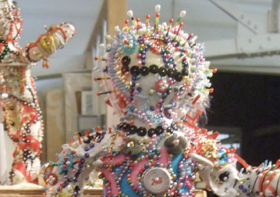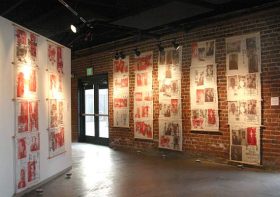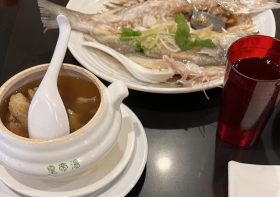Women of Color in Art: WoCA Slide Project
This essay written by Flo Oy Wong in 1998, recounts the history of the Women of Color in Art (WoCA) Slide project for a sample 8-week syllabus for “Women Artists of the American West” for Purdue University’s Rueff School of Design, Art, and Performance, College of Liberal Arts. “Asian American Artists” consisted of a collection of images and texts by twelve artists who live and work in the American west. Their materials were complemented by historical essays about two Asian American arts organizations: Women of Color in Art (WoCA) of the Women’s Caucus for Art and the Asian American Women’s Artist Association (AAWAA).
Asian American Artists: Women of Color in Art (WoCA) Slide Project History
In early 1997, the Women’s Caucus for Art (WCA) Women of Color national slide set was made available for purchase. These slides, which represent the art of under-recognized and established, mid-career and emerging women of color artists throughout the United States, meet a need in the American art establishment. They provide sorely needed resources to artists, art historians and writers, curators, art institutions, universities, colleges, galleries and museums, for exploratory studies and documentation in contemporary art curricula on a national level. They also set the stage for the possibility of including works by these artists for exhibition, so that the art of women of color becomes more visible in the contemporary art world.
How and why was this project created? Who were the people involved in developing such a significant resource through the Women’s Caucus of Art, the major national organization for women actively engaged in the visual arts professions? Founded in the early 1970s, the WCA was committed, among its multiple goals, to ensuring the inclusion of contributions of women and people of color in the history of art. This essay tells how this project was created through the hard work of the Women of Color in Art Committee (WoCA) of the WCA. Among those artists based in the American West, those who worked on this project were Yong Soon Min, Gail Tremblay and myself. In the late 1980s, it became clear to Moira Roth, Trefethen Professor of Art History at Mills College (in Oakland, California), that inequality existed for artists of color regarding exhibitions and publications. Looking to create equity for women artists of color, in 1989, Roth approached Chris Havice, then president of the WCA. Roth suggested that it would be a good focus for the WCA to devote time, money and political energy to creating national slide packets from various women of color communities in the United States. It was imperative that women of color take charge of the project. At a February meeting, following the conclusion of the WCA national conference in San Francisco, Amalia Mesa-Bains, Theresa Harlan, Jaune Quick-To-See Smith, Gail Tremblay and myself were among the artists convened to see if the slide packet idea was worthwhile, and whether the project would be right for women artists-of-color.
It was from that seminal San Francisco meeting that the vision for the WCA WoCA slide project developed. I was asked to contact Asian American women artists, while other committtee members were asked to organize within their respective communities. With the help of Betty Kano, a Berkeley, California-based artist, I collected Asian American women artists’ slides as requested. The original plan was for me to send these slides on to the WCA to start the proposed slide project. The WCA’s goal was to secure a National Endowment for the Arts (NEA) grant to publish the slide packets. By March of 1989, several Asian American women artists who had submitted slides, gathered at a meeting in Berkeley, to view the growing slide collection. Energized by meeting one another, the artists established the Northern California-based Asian American Women Artists Association (AAWAA), an organization formed to promote the visibility of Asian American women artists in the national art arena. Bernice Bing, a recipient of the 1996 WCA Lifetime Achievement Award, became an early AAWAA member, along with Betty Kano, Moira Roth and myself. When the WCA’s proposal to publish slide packets was later rejected by the NEA, we decided to temporarily house the Asian American women artists’ slides at the Mills College Art Department slide library, until we could find some other way to fund their publication.
In 1991, I accepted an invitation to join the WCA national board of directors. I focused my attention on the gestating slide project. Two years later, in 1993, when Jean Towgood of Huntington Beach, California, served as national WCA president, the board of directors supplied seed funding. By then, a revitalized Women of Color Caucus was formed under the leadership of Imna Arroyo, Vice President of Women of Color. Diverse WCA board members, including white women artists, from throughout the United States – Terri Cohn, Gloria Maya, Eleanor Merritt, Rosalyn Mesquita, Leslee Nelson, Rae Atira-Soncea, Sandra Rowe, Gail Tremblay and myself – formed the working slide project committee. Plans were formulated to call for slides. Nelson, art professor at the University of Wisconsin, Madison (UWM), assisted by Atira-Soncea, became the first project manager. She organized the slides and auxiliary materials, creating artists’ files, with support from the art department of UWM.
1994 fostered much project activity. Slides collected from African American, Asian Pacific American, Latina American and Native American national communities were presented at the New York WCA Conference. By then, Arroyo assumed management of the project and artist Yong Soon Min joined the working committee. She and I crafted letters to invite prominent women of color curators – Margaret Archuleta, Deidre Bibby, Evelyn Figueroa, Theresa Harlan, Karin Higa, Margo Machida, Tere Romo and Deborah Willis – to select the national slides. The curators of color accepted the WCA Women of Color invitation. Gloria Maya, a WCA board member from New Mexico, suggested a name change from Women of Color Caucus to Women of Color in Art (WoCA) and designed the new logo. Atira-Soncea created the contract for juried artists. Next came the creation of the WoCA slide bilingual English and Chinese video by Arroyo and her daughter, Isis Mattei. Arroyo and I co-wrote the script. The video premiered at the 1995 Fourth International Women’s Conference in the People’s Republic of China.
Returning home from the International Women’s Conference, WoCA committee members proceeded to the next project phase. Directed by Merritt, the new project director and board member form Florida, WoCA organized a juried exhibition of women artists of color in San Antonio, Texas, site of the 1995 WCA Conference. Anita Valencia, a San Antonio artist, juried the show. The challenging task of the national jurying of slides began in San Antonio with Higa, Machida and Romo. Merritt explored the possibility of outside funding, and searched for commercial companies to publish the slides. A second WoCA exhibition, featuring the works of artists selected by the national curators of color, took place in 1996 in Boston, site of the WCA National Conference. Merritt funded and published an exhibition catalogue, donating the proceeds from the catalogue sales to the WCA. She contacted the Universal Slide Company in Sarasota, Florida, who agreed to publish the slides.
In 1997, the Universal Color Slide Company began marketing the WoCA slide resource packets. That action culminated eight long years of dedicated work by WoCA, on behalf of national women artists of color. The project demonstrated the WCA’s good faith to include the contributions of women of color and gender-based issues in the landscape of American art. Because of unwavering support from past WCA Presidents Jean Towgood and Helen Klebesadel, the project succeeded. It was right, as Roth had hoped, for women of color artists*.
Two original members of the 1989 committee – Tremblay and myself – saw the project to the end.
*Editor’s note: a selection of eight Asian American artists from the WoCA slide project is featured in Women Artists of the American West.



Leave a Reply